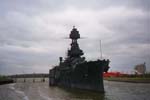 |
The San Jacinto monument, east of the city of Houston, TX. The monument
marks the location of the 1836 battle of San Jacinto, which concluded the
Texas Revolution. The obelisk is topped with a massive star. They are
apparently cleaning it.
|
 |
A view from the observation deck inside the tower. This is facing
approximately WNW, over the ship channel. You can see the reflecting pool and
the battleship U.S.S. Texas. Downtown Houston would be just out of frame to
the left. The cable in the foreground was part of the rigging being used for
restoration of the monument.
|
 |
Another view from the observation deck. This view is approximately
NNE, looking over the ship channel and the bayou.
|
 |
The U.S.S. Texas is the only ship to have fought for the United States
Navy in both World War I and World War II. It was the last of the
American "dreadnoughts." It is now in a permanent mooring next to the Houston
Ship Channel and the San Jacinto Monument. This is looking at the stern of
the ship.
|
 |
This is a view from the main deck, port side, about amidships, looking
to the stern. On the left of the frame, you can see the steam stack, and to
the right of the frame you can see one of the two cranes on the ship.
In the center of the frame is the stern superstructure.
|
 |
On the main deck, port side, looking to the bow. These are anti-aircraft
guns, added in World War II before the ship entered the Pacific theater.
You can also see the concrete walkway now used to board the ship, and the
Houston Ship Channel beyond.
|
 |
Standing near the stern of the ship, looking back toward the bow.
The large radar antennas on the stern superstructure were added during
the second World War.
|
 |
The radar room. This was on the deck immediately below the
main deck. There was a metal screen in the door to this room.
|
 |
A bunk space. This was not actually a separate room, just an alcove of
sorts off the main hallway on the starboard side of the ship. I was
standing in the hallway, and there were lockers on the wall behind me.
|
 |
A view from about halfway up the stern superstructure, looking out over
the bow. The U.S.S. Texas was the last of the steam powered battleships to
enter service in the United States Navy. Originally, this was a coal-burning
ship, but was converted to oil before the second World War. The steam
funnel is in the foreground here.
|
 |
On the other side of the stern superstructure, looking out across the stern
of the ship. The San Jacinto monument is on the small hill ahead. The U.S.S.
Texas is now painted entirely in a dark blue camoflage, the same color
scheme it wore in the Pacific theater at the end of World War II.
|
 |
The U.S.S. Texas was commissioned in 1912. It has two heavy cranes, one
on each side of the ship. The cranes were used to lift the ship's sea
planes and small boats out of the water and bring them back aboard. You can
also see a ship travelling past the mooring in the Houston Ship Channel.
|
 |
This is as high as one can get on the superstructure of the ship.
While it's not obvious from this photo, to go higher requires climbing
ladders on the outside of the three columns that hold up the higher portions
(which of course are off limits to visitors today.)
|
 |
Some of the anti-aircraft gun emplacements.
|
 |
The view, looking stern, underneath the stern-most big gun, at the
San Jacinto monument.
|
 |
Standing near the bow, looking toward the stern. This is a good view
of the forward superstructure.
|
 |
This is a view inside one of the big guns. This is the left of two
firing chambers in the gun. Shells were brought up from the magazine
below the turret.
|
 |
A better view of the stern superstructure.
|

















